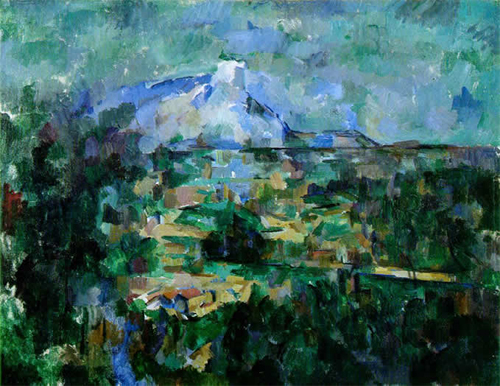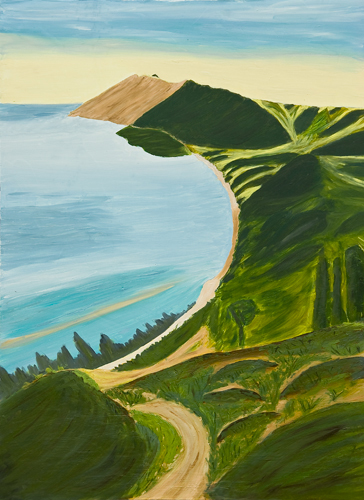
View from Empire Bluff, Sleeping Bear Dunes, Michigan
oil on maple, 24 x 18 inches.
This spring, I started sketching landscapes on paper rather than only photographing them. My first motif was the view from a bluff. Doing an oil painting on site would be cumbersome because it would mean dragging supplies uphill along a 20 min hike.
Hoping to get help in understanding the contours of the dunes, I started reading Philip Ball’s trilogy on ‘Nature’s Patterns: a tapestry in three parts’. In the first chapters of ‘Shapes’, Ball talks about Rene Binet’s design for the entrance gate to the World Exposition of 1900 in Paris that was inspired by the radiolarian drawings of the German biologist Ernst Haeckel. Apparently, Haeckel was both influenced by Art Nouveau and its German equivalent ‘Jugendstil’ and influenced it in turn. Ball continues writing about the projective geometry, physics and chemistry of soap bubbles, hexagonal honeycomb patterns and ‘ideal foam’ portrayed in the swim center for the 2008 summer Olympics.
After painting the distant ‘Bear’ Dune and the calm, glassy-looking water from my sketch, I started on the foreground. Frustration set in.
In middle May, the early morning sun had thrown deep, dramatic shadows over the smallish sand elevations which I had failed to sketch in with enough detail. By now, in June, the early morning sun illuminated yellow-green vines and blue-green grass in the foreground that were too complex to fit into my painting.
To seek inspiration, I looked at one of Cezanne’s painting with deep shadows in the foreground:

This helped me to change the foreground as seen as the first illustration in the post.


A striking work, Brigit. As I read of your readings on Nature’s Patterns, I imagined your jutting, green and brown earth as the beginnings of a nautilus shell.
I love the pattern of light and dark green, it feels decadent which contrasts nicely with the bold shape of the land.
Sorry, I accidentally misspelled your name.
Tree,
Intuition! A shell, probably a nautilus, shell is featured on the front cover of ‘Shapes’.
Why decadent? Does it remind you of the green-yellow velvet pants worn by men some ages ago?
Birgit:
I’ll need a little time to digest this image. Meanwhile, let me say that it is good to see something up on A&P.
Jay,
I feel that way too. My thoughts had been on writing stuff for my day job. But now, I am back and engaged. I am looking forward to your critique on the image.
I’m with both of you, I was really happy to see something new. I’ve been so busy lately but hope to write something new soon.
Birgit, I didn’t think specifically of pants but yes, a gorgeous velvet comes to mind. Something to get lost in.
And how cool is that about the book cover? I’ve never seen it, by the way.
Tree;
Ball’s trilogy discusses: shapes, flow and branches. Jay found this science writer for me when I wanted to learn more about pigments. He also wrote
‘Bright Earth: Art and the Invention of Color’.
Birgit:
Seems like ages since I have had anything much to say on A&P. It feels as though I have left my mind out to pasture and now it doesn’t want to be led back to the barn.
I can see what you mean about the foreground as it does have a sketchy quality for now. But at the same time I’m not all that bothered by the tentative nature either of the layout or the details.
One confusing thing: did you haul the board out to the location on six consecutive occasions, or work on it in the studio in six sessions? You likely make yourself clear on this point, but I’m not picking up. Point is that I’m fascinated by the second possibility in that the piece has a memory-based feel to it, which can contribute to its charm.
If I remember correctly, in reference to the big dune, I talked earlier about areas of greatest interest being most sharply delineated. The same aspect appears here in that that clean wedge of sand is the apex to which the eye is drawn. Anyone who has visited the dunes will agree that the dune with its big straight drop into the lake demands attention.
The detailing of the shoreline is countered by the generalized treatment of the lake and sky. Admitted, they both are full of subtlety and hard to paint, but the feel I get is a place-holding manner of painting them: their scales and relative locations are indicated, but they don’t seem to enter into much of a conversation with other elements.
Let me stop there for now. I’ve got an unfinished painting of a light house that is driving me nuts and I don’t feel all that qualified to be critiquing any other work at this point.
Jay,
I have been trudging up the trail to the Empire Bluff every morning with a sketch pad, 12 x 9 inches, to draw from different points on the board walk on top. Then, back in my Studio, I amplified one of the sketches on a 24 x 18 board. When I realized that I missed detail from the foreground of my painting, it took me a little searching to figure out where its particular sketch was done. After I found it, I make good on my inattentiveness by sketching there for 6 consecutive mornings so that its geometry began to look familiar like an old friend. Many others had dealt with the foreground by picking a spot that put a dead tree (that, happily, by now has fallen down) into their view.
I am fascinated by your analysis that …they don’t seem to enter into much of a conversation with other elements. What comes to mind is my lack of experience. A glassy-looking water surface is a new subject and green is not a color that I feel very comfortable with yet. The solution is easy, just continue painting. Two possible developments are (1) I will create greater harmony or (2) greater alienation between water and land. Would the latter lead me into the company of surrealists?
When do we get to see the lighthouse?
Jay,
Another possibility for the lack of correspondence between some of the elements in the painting is the manner in which the picture progressed. I wrote the general colors that I saw from the top of the bluff into the shapes of the sketch. I now realize that I that that may have been a crude way of remembering all the subtleties of the hues. The solution may be to carry my camera along and snap details.
I don’t think that it would be possible to do such a painting alla prima. The shadows on the slopes change quickly in the rising sun at 6:30 am and the water surface does not remain still.
Seeing that glassy surface of the lake was a fleeting experience. One morning, a few clouds over the lake, illuminated yellow-pink and surrounded by purple hues, produced an amazing light show of reflections in the lake. Not having had my camera in my knapsack, it only lives in my ‘mind’s eye’. For the last three weeks, the wind has been rippling the water surface, making it look grey from my distant point of view.
Birgit:
Chances are that that lighthouse will lit out for the scrap heap before long. I sometimes hold onto a project too long, unwilling to admit that it is ill-conceived and poorly begun.
I may have overspoke. Your sky shares in the tawny coloration of the sand and that’s a nice touch. It’s hard to know what to do with the lake as your present approach emphasizes a kind of delineation in the sense that your landscape is more particularized than generalized. There’s a fellow named Jones in town who paints landscapes in a similar manner and they look fine.
You may remember that I saw the lake from your very same boardwalk last Memorial Day as the sun was setting and it was gorgeous and virtually unpaintable. It’s also fairly featureless in the sense that there are few if any great rolling whitecaps or big ships going by. Maybe you could include word balloons like in the comics and have the dunes talking to the lake and likewise the lake the dunes.
Jay,
Great idea to have dunes and lake talk via word balloons. Using AP, I lightened the blue of the sky a little on the left, perhaps that will help the sky talking to the lake. Perhaps, I play little with the greens towards the sun.
Who is your painter Jones? Googling for Jones, I came across this marvelous landscape.
I have not seen the sunset from the Empire bluff. How do you get back down through the forest in the dark? I usually take my visitors to watch the sunset from the Pierce Stocking drive.
Birgit:
Google Brian Jones Galleries. He’s a journeyman painter in the sense that he paints for the market and a lot of things will not relate to our discussion. But there is a mosaic-like quality in some of his work that I find germane.
The word balloons could be in colors and textures – the language of land and lake.
There’s a parking lot down there and a well-worn path to and from it. We left the bluff soon after the sun had set and had plenty of illumination.
One more thing: the land to the right dips below the lake’s horizon. Is that intentional?
Jay,
The line of the distant dune is horizontal, as I sketched it again this morning. The slope may have gone about because of my love of diagonals.
Our discussion has been fruitful in that it has clarified for me in what ways the pictures is unfinished. Looking at Brian Jones’ style has been interesting.
The tiger lilies on the bluff are blooming now .
I like this painting very much! Especially how the line of pines lean left at the bottom of the lake. The shapes are strong and active.
Thanks, Kathy,
I am still working on the very foreground which is difficult for me. It occurred to me that, as a child, walking along a bay of the North Sea, I got into the habit of looking over long distances instead of scrutinizing what was at my feet. Similar to a kitten reared in an environment of vertical stripes that stumbles over a horizontal barrier because it cannot see it.